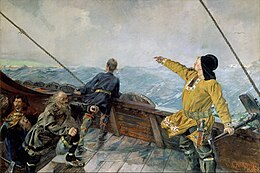 Global Information
Global InformationEastern Settlement information
| Part of a series on the |
| Norse colonization of North America |
|---|
 |

The Eastern Settlement (Old Norse: Eystribygð [ˈœystreˌbyɣð]) was the first and by far the larger of the two main areas of Norse Greenland, settled c. AD 985 – c. AD 1000 by Norsemen from Iceland. At its peak, it contained approximately 4,000 inhabitants. The last written record from the Eastern Settlement is of a wedding in Hvalsey in 1408, placing it about 50–100 years later than the end of the more northerly Western Settlement.[1]
Despite its name, the Eastern Settlement was more south than east of its companion and, like the Western Settlement, was located on the southwestern tip of Greenland at the head of long fjords such as Tunulliarfik Fjord or Eiriksfjord, Igaliku or Einarsfjord, and Sermilik Fjord. Approximately 500 groups of ruins of Norse farms are found in the area, with 16 church ruins, including Brattahlíð, Dyrnæs, Garðar, Hvalsey and Herjolfsnes.[2] The Vatnahverfi district to the southeast of Einarsfjord had some of the best pastoral land in the colony, and boasted 10% of all the known farm sites in the Eastern Settlement.
The economy of the medieval Norse settlements was based on livestock farming – mainly sheep and cattle, with some seal hunting. A Little Ice Age in the 14th century may have increased the demand for winter fodder and at the same time decreased productivity of hay meadows. Isotope analysis of bones excavated at archaeological investigations in the Norse settlements has found that fishing played an increasing role towards the end of the settlement's life. While the diet of the first settlers consisted of 80% agricultural products and 20% marine food, from the 14th century the Greenland Norsemen had 50–80% of their diet from the sea.[3][4]
In the Greenlandic Inuit oral tradition, there is a legend about why the Norse population of Hvalsey died out and why their houses and churches are in ruins. According to the legend, the reason was a blood feud between local Norse chieftain Ungortoq and a young but determined Inuit warrior named K'aissape. In revenge for Ungortoq's slaying of his younger brother, Inuit warriors under K'aissape approached Hvalsey by sea while disguised as an iceberg and then burned down the Norse settlers inside their houses, but Ungortoq escaped with his family. K'aissape finally hunted down and slew Ungortoq and his whole family near Cape Farewell.[5] According to archaeological studies, there is no sign of a conflagration. Other explanations have also been offered, including soil erosion due to overgrazing and the effects of the Black Death.[6][7]
Major parts of the Eastern Settlement, including Brattahlíð, the homestead of Erik the Red, were included on the UNESCO World Heritage List in 2017 as Kujataa Greenland: Norse and Inuit Farming at the Edge of the Ice Cap.[8]
- ^ Brown, Dale Mackenzie (February 28, 2000). "The Fate of Greenland's Vikings". Archaeological Institute of America. Retrieved February 18, 2023.
- ^ Svitil, Kathy A. (July 1, 1997). "The Greenland Viking Mystery". Discover Magazine. Retrieved February 18, 2023.
- ^ Arneborg, Jette; Heinemeier, Jan; Lynnerup, Niels; Nielsen, Henrik L.; Rud, Niels; Sveinbjörnsdóttir, Árný E. (1999). "Change of diet of the Greenland vikings determined from stable carbon isotope analysis and 14C dating of their bones" (PDF). Radiocarbon. 41 (2): 157–168. doi:10.1017/S0033822200019512. S2CID 115135183.
- ^ Dugmore, Andrew J.; et al. "Norse Greenland settlement and limits to adaptation" (PDF). North Atlantic Biocultural Organization cooperative. Archived from the original (PDF) on 2015-09-07. Retrieved January 20, 2016.
- ^ Dr. Henry Rink (1875), Tales and Traditions of the Eskimo, with a Sketch of their Habits, Religion, Language, and Other Peculiarities, William Blackwood and Sons, London and Edinburgh. Pages 308-317.
- ^ Helgason, Magnús Sveinn (December 18, 2015). "What happened to the Viking settlement of Greenland? New research shows cooling weather not a factor". Iceland Magazine. Archived from the original on February 19, 2016. Retrieved January 20, 2016.
- ^ Dugmore, Andrew J.; et al. (December 23, 2011). "Cultural adaptation, compounding vulnerabilities and conjunctures in Norse Greenland". Proceedings of the National Academy of Sciences of the United States of America. Retrieved January 20, 2016.
- ^ UNESCO World Heritage Centre. "Kujataa Greenland: Norse and Inuit Farming at the Edge of the Ice Cap". UNESCO World Heritage Centre. United Nations Educational, Scientific, and Cultural Organization. Retrieved 30 July 2021.